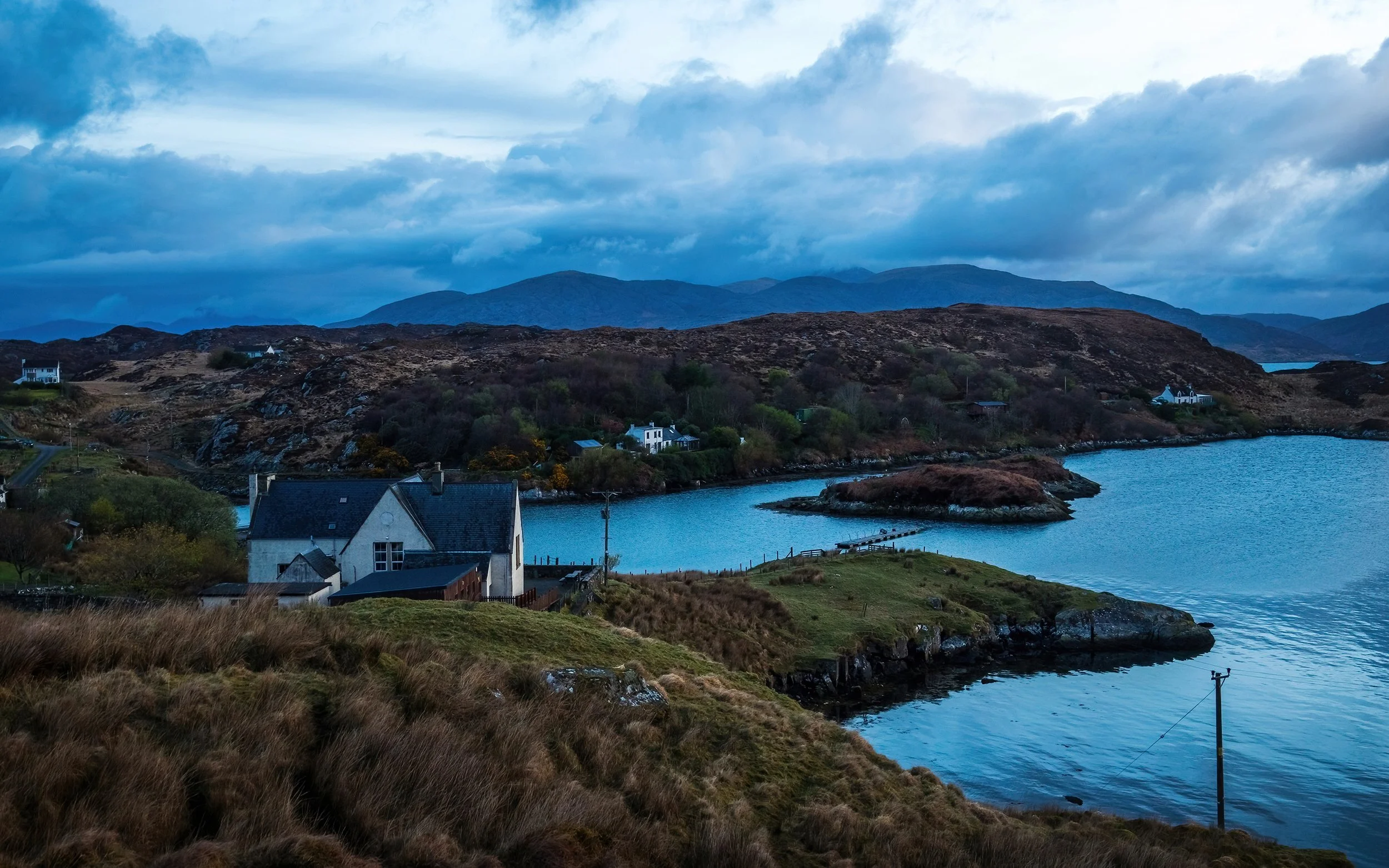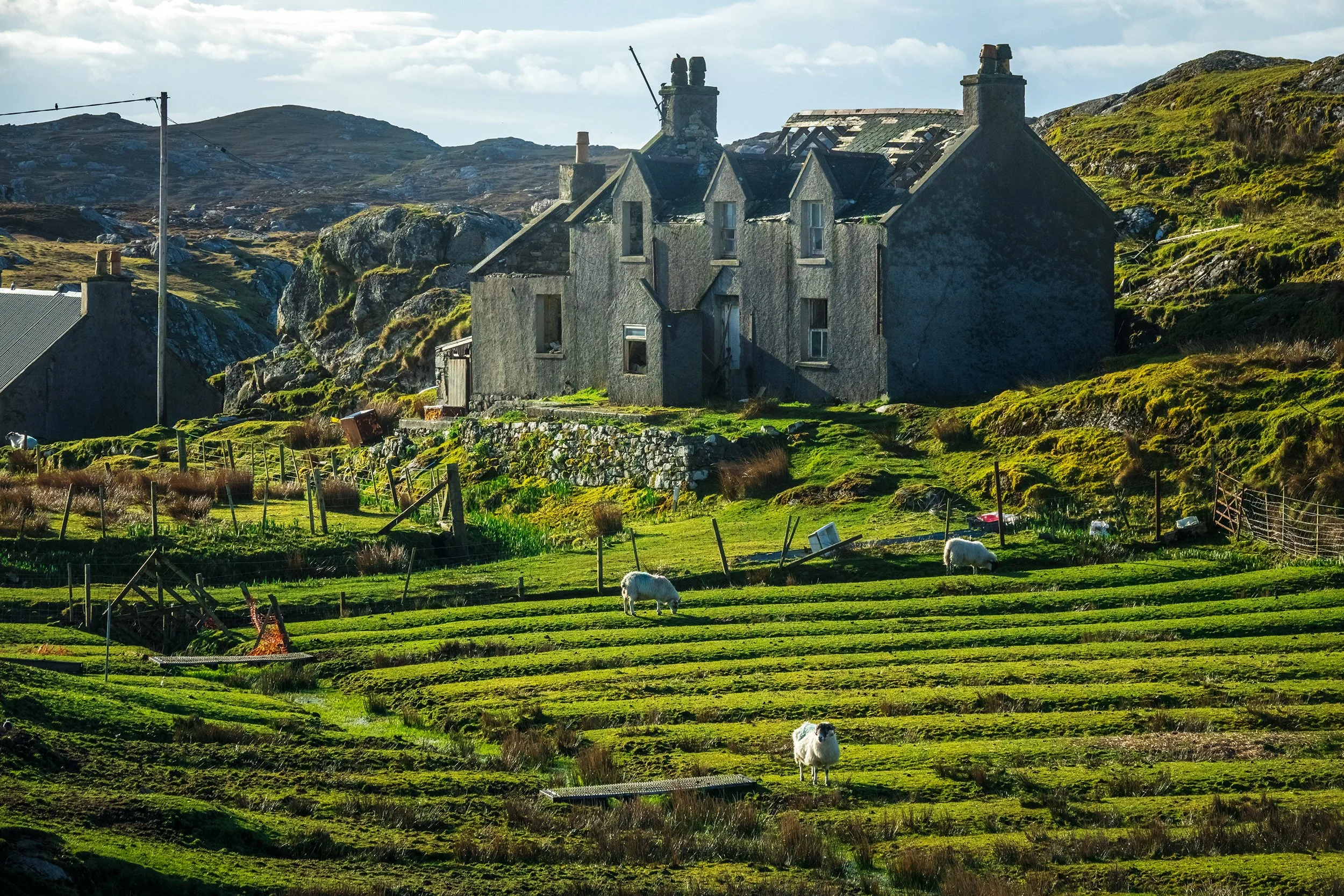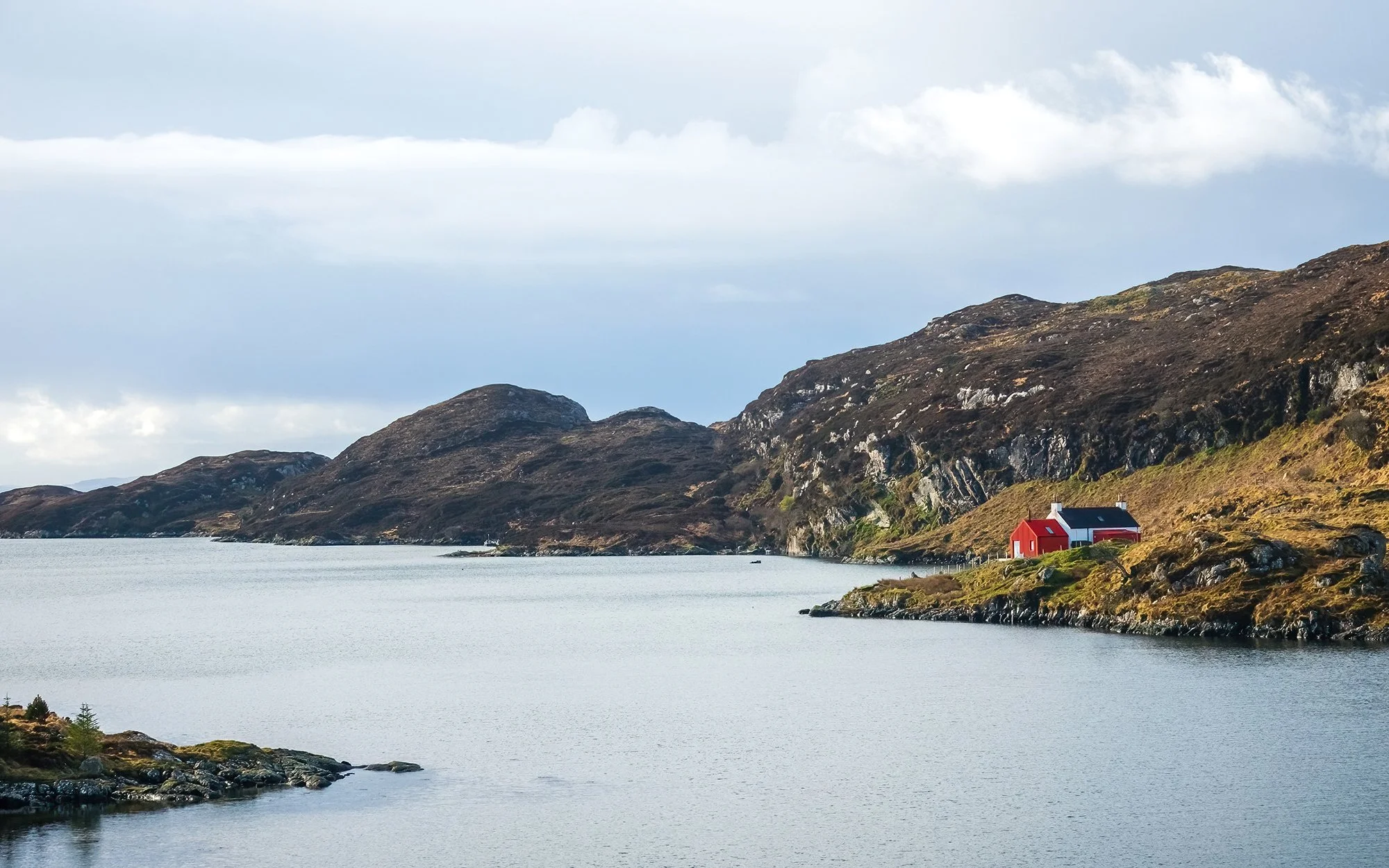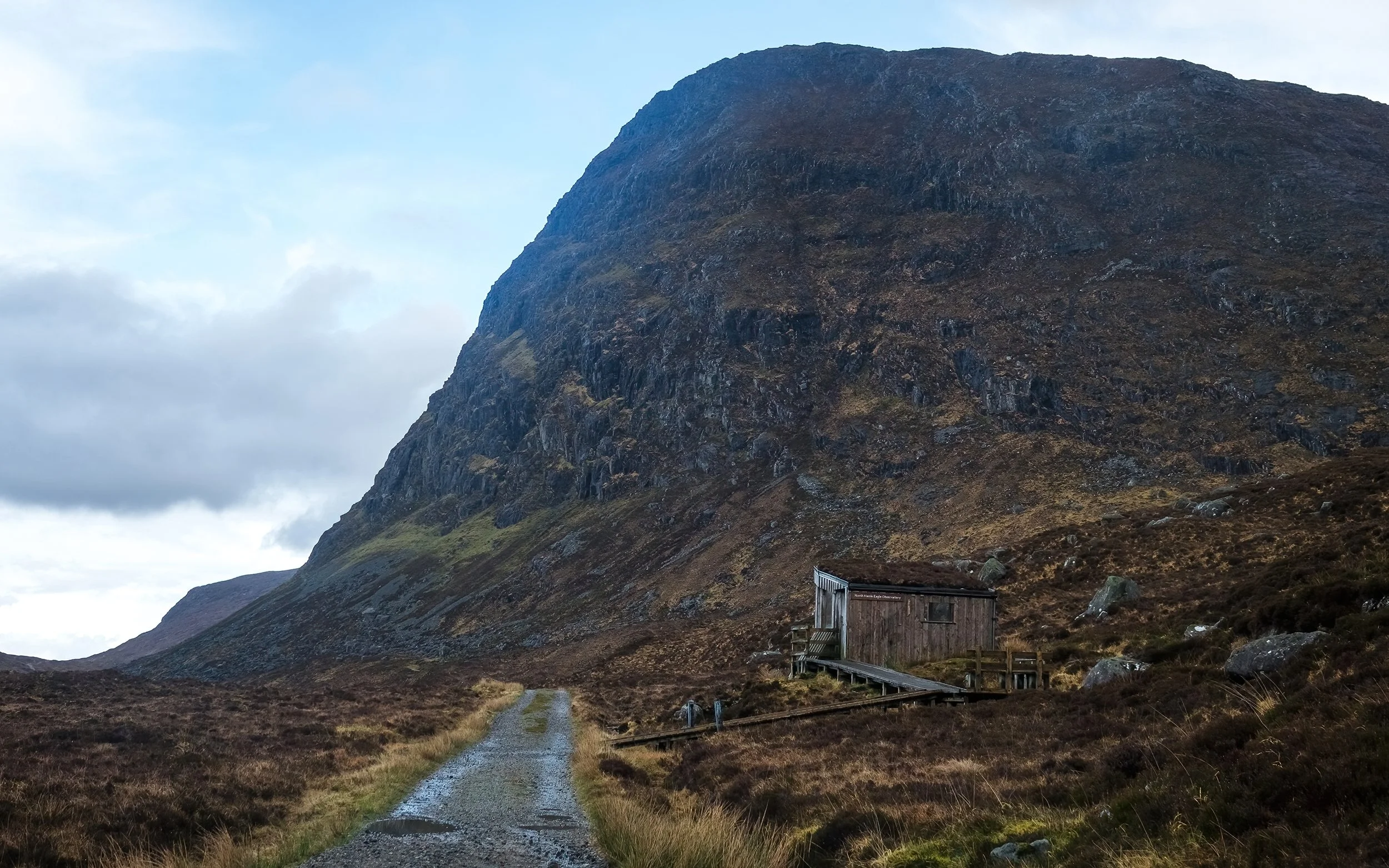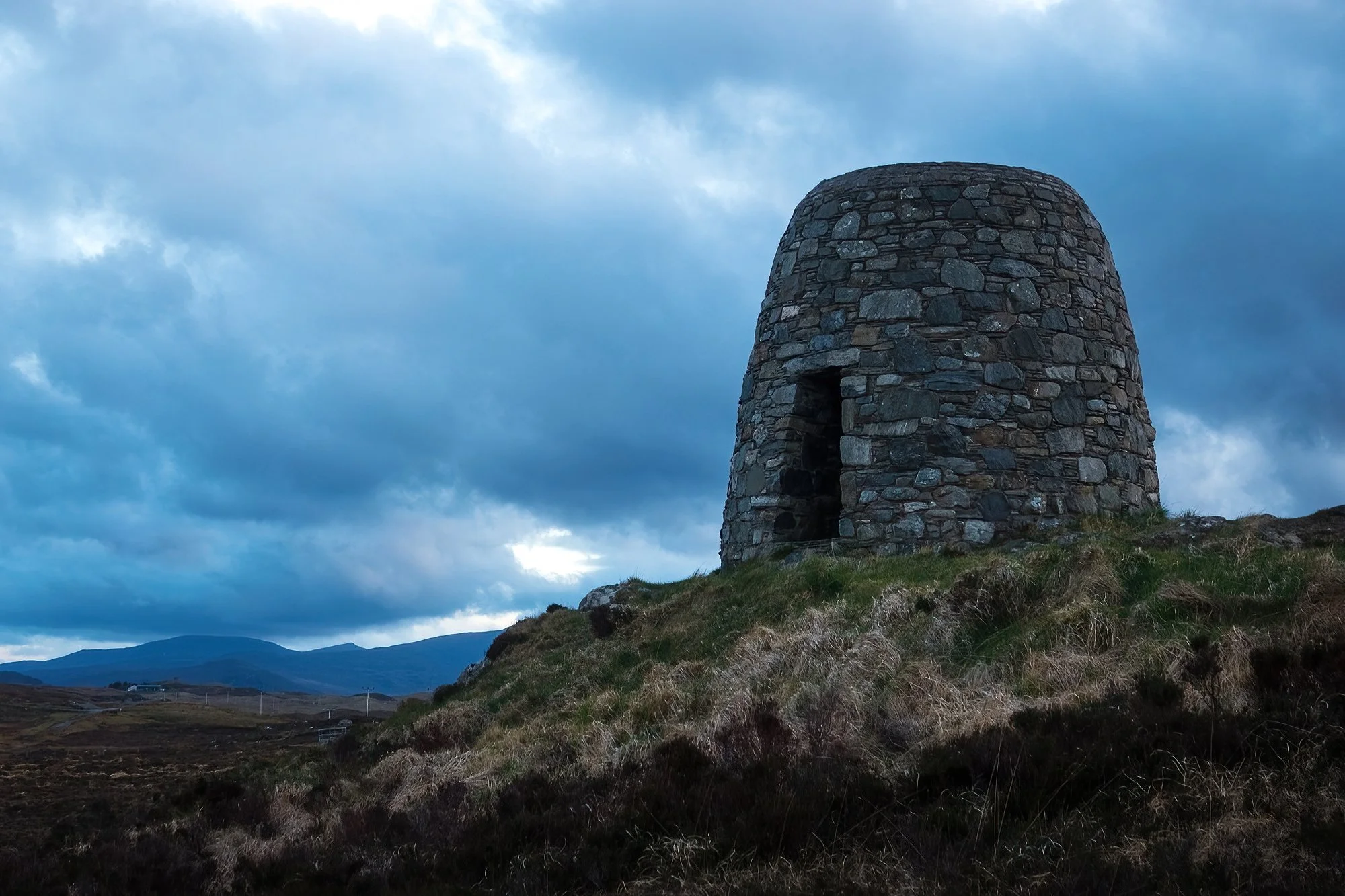“I have felt at times, and perhaps this is a kind of delirium, no gap between me and the place. I have absorbed it and been absorbed by it, as if I have had no existence apart from it. I have been shaped by those island times, and find it difficult now to achieve any kind of distance from them. The place has entered me. It has coloured my life like a stain. Almost everything else feels less dense and less intense than those moments of exposure. The social world, the political world, the world of getting on with work and a career - all those have been cast in shadow by the scale and seriousness of my brief moments of island life.”
- Adam Nicolson
Sea Room
“From there the road rose steeply, carved out of the mountainside, a spectacular view opening out below them of the black, scattered waters of the loch. The mountains folded around them, swooping and soaring on all sides, peaks lost in cloud that tumbled down the scree slopes like lava… And then, suddenly, as they squeezed through a narrow mountain pass, a line of golden light somewhere far below dimpled the underside of the purple-black clouds that surrounded them. A tattered demarcation between one weather front and another. The grim gathering of cloud among the peaks fell away as the road descended south, and the southern uplands of Harris opened out ahead.”
- Peter May
The Lewis Man
An early start. Rain is drizzling as I wind up the now-familiar road from Loch Máraig to the highway. This morning, my goal is to explore the rocky eastern coast of Harris, of which I only got tantalizing glimpses the day prior. I’ll be driving the Golden Road, a winding, single-track road that connects the old crofting communities along the coast. So named because of the cost of construction, as well as after the economic prosperity that it was hoped the road would bring the region, the Golden Road has failed to deliver on that latter front. Nonetheless, what it does deliver is an memorable morning of exploration and photography, as I visit a series of small villages and townships - by turns lovely, quaint, and uniformly hardscrabble - at the break of dawn and throughout the early morning. I’m following a series of coordinates I’ve plotted down ahead of time to various stops along the sinuous road - mostly places where the lane widens to allow oncoming cars to pass one another - but the morning offers its fair share of surprises as well. All in all, I luck into amazing conditions for photography: a clear dawn gives way to changeable light and weather. Passing rain clouds descend onto the coast from the mountains to the north and west, offering mist and drama. And far to the west, I can see the bold outline of Skye’s Trotternish Peninsula, where Jane and I concluded our island tour almost exactly nine years ago. Paired with this weather, the scenery - of derelict crofts, ruined stone foundations, stony slopes, and shimmering ponds and lochans - produces one of the finest photography experiences of my lifetime. As of this writing, done contemporaneously from Harris in my journal during the early mornings of jetlag and the spare hours of midday, I am having trouble thinking of a finer one. I have always written about how I love island geographies and communities. This morning’s images, of a totally bygone yet still somehow thriving human community on Na Heiradh, should speak for themselves.
My sunrise tour traverses the coast between the communities of Drinishader and Manais, sometimes following the Golden Road and sometimes veering off on foot onto grassy trails between the lochs and the coffin road that bisects the island (so named because it allowed villagers, after funerals in the rocky east, to hand-carry their beloved deceased several miles to the fertile, soft ground of the machair in the west - hence all the cemeteries yesterday and none today). Like the previous day, I’ve eschewed my usual modus operandi - the carefully selected golden hour destination where I plop down with a tripod, a light breakfast, and a lengthy timelapse. Instead, the morning is an agile, moveable feast of photographic compositions from throughout the region, as I quickly move (sans tripod and with image stabilization on) between location and location. Although the road is winding, and it takes time and care to traverse the single-lane track safely, I manage to capture a variety of images in the precious early hours of the morning. Something draws my soul to these island places, where the ruins of the past and the living history of the present are hopelessly, closely intertwined with the changeable light, the oceanic weather, the salt air, and the endless, biting wind. These are the places where hope and love cling on in the hardest of conditions; you can feel them through the viewfinder.


At nine o’clock, with the sun brightening the landscape quickly, I return to the highway and stop in Tarbert town (and what a quaint and cute little town it is) to buy gifts at the Harris Tweed company store: leg warmers, socks, and a lavender wool cardigan for Jane; a matching robin’s egg blue cardigan for myself; wool socks (in several sizes, up to 4-6 years!) and a wool pullover (with a red tractor!) for Jordan; a wool scarf, a birthday gift for a friend; and the obligatory trip magnet). Then, after a pit stop at the local petrol station to fuel up and buy a sandwich for lunch, I make the brief drive to Glen Meavaig in North Harris, passing by more coastal views and a farm with adorable island cows.
At the head of Loch Meavaig, I suit up for a walk up the glen, to the golden eagle observatory beneath the walls of Sròn Scourst. It’s a straight-line walk of just over a mile and a half, but the tempestuous mountain weather (rain, then sleet, then sun, then hail and more rain in the space of half an hour) as well as the imposing mountains enclosing the glen make this a far more dramatic experience than the trail itself would prescribe. Head down and rain hood on, I walk straight forward for what seems like an interminable time, passing by an area of reforestation efforts and crossing over a stream (Abhainn Mhiabhaig) on my way up the valley. To take a few photos of the scenery, I try the umbrella-inside-backpack-strap setup that I perfected on Vancouver Island, but what worked well in Cascadia proves to be no match for the vicious mountain weather of the Scottish isles; I am nearly blown sideways before deciding to never open an umbrella on this trip again. At the eagle observatory (a simple one-room hut with glass windows at the foot of the mountain, I have a brief sit and sign the guest register. With no sight of the area’s pair of nesting golden eagles, I retrace my steps back down the glen, admiring some of its unique flora (such as the ubiquitous bristly haircap mosses, heather, and dog violets).
At the car, I sit on a stone wall overlooking the nearby loch as I eat my lunch (a prawn salad sandwich along with my usual bag of car snacks - bread, dried fruit, and a drink). Then it’s back home to the hut to rest for the afternoon. I am hewing quite well to the photographer’s bimodal sleep schedule, and becoming quite familiar with the rhythms of Loch Máraig outside my door. At the mid-day, the tide is going out, and the gulls and oystercatchers are hard at work, foraging for their own lunches out on the mudflats. I watch them for awhile before climbing into bed.
In the early evening, back into the car for an exploration northward - now ranging onto the Isle of Lewis, contiguous with North Harris and the largest of the Outer Hebridean isles. My first stop is at the Aline Community Woods, a rare stretch of jack pine forest (in fact, one of the few woodlands anywhere in the Outer Hebrides). Here, I take a brief ramble along the forest trails and circle the boardwalk beside Loch na h-Aibhne Ruiadhe - but not before I move my car to the overflow car park because the island’s emergency services personnel are conducting some sort of training exercise (I later bump into them on the lakeside boardwalk, wearing full uniform, big smiles, and carrying a dummy mannequin torso). I take photos of the late afternoon light playing on the hills of North Harris, and some scenes by the water’s edge. Here in spring, the heather and eared willows are beginning to bloom and bud. Feeling sentimental, I circle up to visit the nearby children’s playground before moving on.
I’m driving further north and then east toward the head of Loch Seaforth, a massive sea loch that slices into the southeastern coast of Lewis before opening out to the Minch at Rhenigidale, which I visited two days prior. First, though, I make a roadside stop to photograph the evening’s beautiful light conditions near the tearstone-shaped monument to the Bonnie Prince Charlie, who escaped this way shortly after his disastrous defeat at Culloden. After fleeing this way to the shores of Loch Seaforth, the royal fugitive was conveyed southward throughout the Outer Hebrides to Benbecula, from where Flora MacDonald of South Uist famously rowed the Bonnie Prince to Skye, disguising him as her maid.
My sunset tour continues with a derelict house in the township of Ballahan - a location that I spotted during the preponderance (read: years) of research and planning that went into this trip. Then, it’s back to the turnoff toward the head of Loch Seaforth. The road here, a narrow single-track with scarce passing space, winds up over an expansive moorland studded with ponds before descending to the hillside overlooking the sea loch. Here, I stop beside the ruined foundation of Clan MacKenzie’s old castle, built in 1620 by Kenneth MacKenzie and inhabited by his successors the Earls of Seaforth, who ruled over Lewis for 200 years. The evening light is stunning, and from a distance, I photograph the interplay of light and colour in the clouds above the loch.
Sun is setting now. I return back over the moors, stopping one last time at a roadside broch-monument built to commemorate the men who tried in court for conducting the Pairc Deer Raid in 1888, an illegal and intentionally very public hunt to protest the clearance and eviction of the Pairc district’s residents to make way for sheep farms and deer forests. Life was hard on Lewis not so very long ago; in my mind, I wonder how modern Hebrideans see the tremendous history imbued within the island landscape, being just a few generations removed from the hardscrabble folk who fought and loved fiercely in order to eke out lives here on the edge of the Atlantic. From the top of the broch, where there are numbered stones taken from the homes of the six ringleaders, I photograph the final colours of sunset overlooking the moors. Then it’s back to Loch Máraig to eat dinner (shepherd’s sauce with brown sauce, salmon, and corn - all sourced from the grocery store), pack, and spend a final night. All in all, it’s been a fantastic day of photography - the best single day I can ever recall in my entire life, in terms of light and weather conditions, and the quality and quantity of compositions. Harris has treated me well, but it’s time to move on to Lewis for the remainder of the trip.




